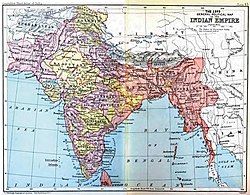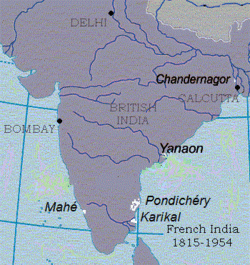Inde française
| Établissements français dans l'Inde | ||||||||||||
| French India | ||||||||||||
| French colony | ||||||||||||
|
||||||||||||
|
French India after 1815
|
||||||||||||
| Capital | Pondichéry | |||||||||||
| Languages | French, Tamil, Telugu, Malayalam, Bengali | |||||||||||
| Political structure | Colony | |||||||||||
| Head of state | ||||||||||||
| • |
King 1769-1774 |
Louis XV of France | ||||||||||
| • |
President 1954 |
René Coty | ||||||||||
| Commissioner | ||||||||||||
| • | 1673 (first) | François Caron | ||||||||||
| • | 1693 (last) | François Martin | ||||||||||
| High Commissioner | ||||||||||||
| • | 1947-1949 (first) | Charles François Marie Baron | ||||||||||
| • | 1954 (last) | Georges Escargueil | ||||||||||
| Historical era | Imperialism | |||||||||||
| • | Abolition of French East India Company | 1673 | ||||||||||
| • | De facto Transfer | November 1, 1954 | ||||||||||
| Area | ||||||||||||
| • | 1948 | 508.03 km² (196 sq mi) | ||||||||||
| Population | ||||||||||||
| • | 1929 est. | 288,546 | ||||||||||
| • | 1948 est. | 332,045 | ||||||||||
| Currency | French Indian Rupee | |||||||||||
|
||||||||||||

Imperial entities of India
|
|
| Dutch India | 1605–1825 |
|---|---|
| Danish India | 1620–1869 |
| French India | 1769–1954 |
|
|
|
| Casa da Índia | 1434–1833 |
| Portuguese East India Company | 1628–1633 |
|
|
|
| East India Company | 1612–1757 |
| Company rule in India | 1757–1858 |
| British Raj | 1858–1947 |
| British rule in Burma | 1824–1948 |
| Princely states | 1721–1949 |
| Partition of India |
1947
|
|
|
|
French India, formally the Établissements français dans l'Inde ("French establishments in India"), was a French colony comprising geographically separate enclaves on the Indian subcontinent. The possessions were originally acquired by the French East India Company beginning in the second half of the 17th century, and were de facto incorporated into the Union of India in 1950 and 1954. The French establishments included Pondichéry, Karikal and Yanaon on the Coromandel Coast, Mahé on the Malabar Coast and Chandernagor in Bengal. French India also included several loges ("lodges", subsidiary trading stations) in other towns, but after 1816, the loges had little commercial importance and the towns to which they were attached came under British administration.
By 1950, the total area measured 510 km2 (200 sq mi), of which 293 km2 (113 sq mi) belonged to the territory of Pondichéry. In 1936, the population of the colony totalled 298,851 inhabitants, of which 63% (187,870) lived in the territory of Pondichéry.
France was the last of the major European maritime powers of the 17th century to enter the East India trade. Six decades after the foundation of the English and Dutch East India companies (in 1600 and 1602 respectively), and at a time when both companies were multiplying factories on the shores of India, the French still did not have a viable trading company or a single permanent establishment in the East.
Historians have sought to explain France's late entrance in the East India trade. They cite geopolitical circumstances such as the inland position of the French capital, the size of the country itself, France's numerous internal custom barriers and parochial perspectives of merchants on France's Atlantic coast, who had little appetite for the large-scale investment required to develop a viable trading enterprise with the distant East Indies.
...
Wikipedia

